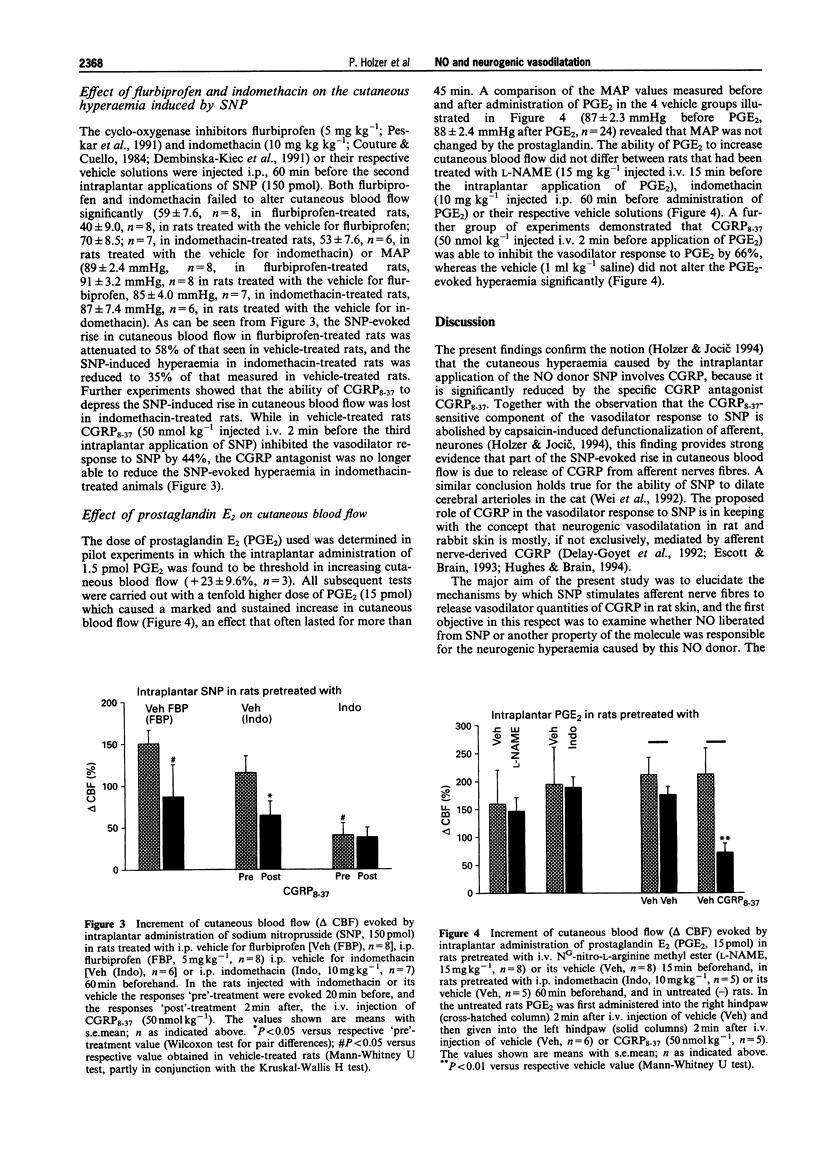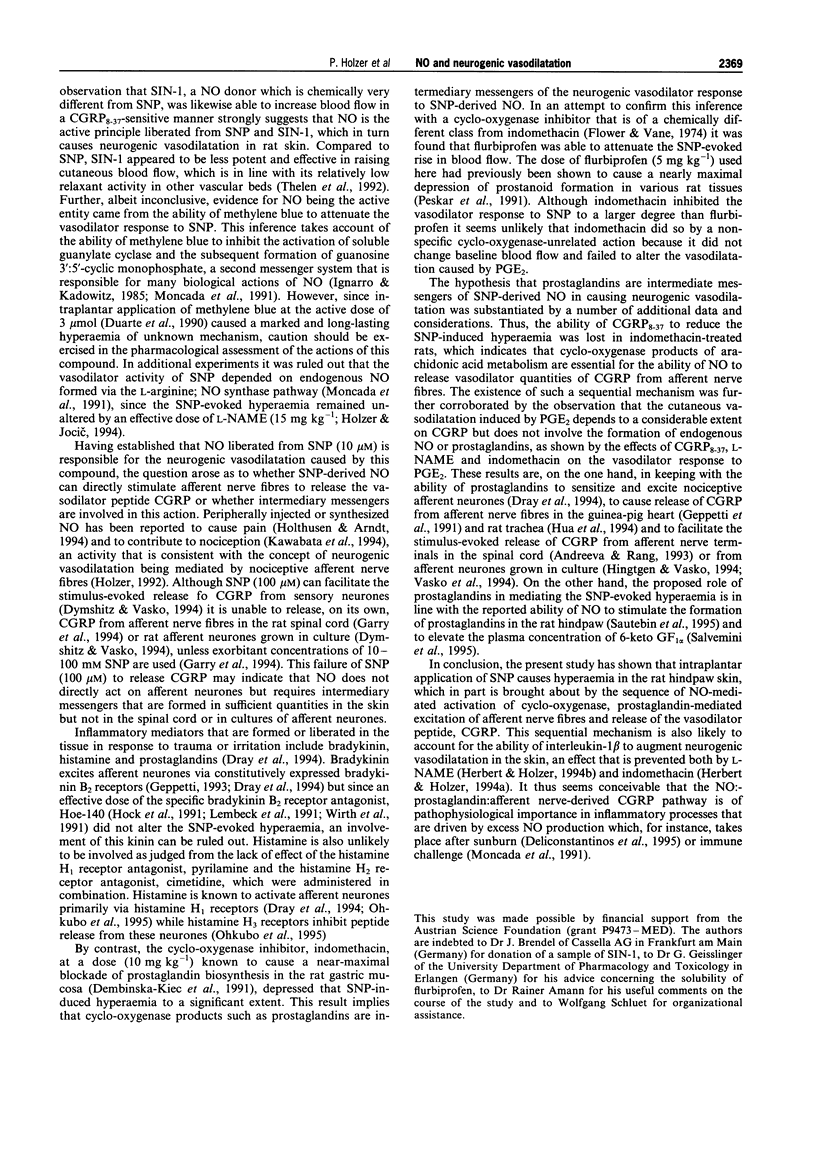Abstract
1. Intraplantar administration of the nitric oxide (NO) donor, sodium nitroprusside (SNP), induces hyperaemia in the rat paw skin, which is in part due to release of calcitonin gene-related peptide (CGRP) from afferent nerve fibres. The present study examined whether prostaglandins or other inflammatory mediators participate in the neurogenic vasodilatation caused by SNP. Blood flow in the plantar hindpaw skin of urethane-anaesthetized rats was measured by laser Doppler flowmetry. 2. The hyperaemic responses to intraplantar administration of the NO donors SNP (150 pmol) and 3-morpholino-sydnonimine (SIN-1, 15 nmol) were attenuated by 45% and 61%, respectively, after injection of the CGRP antagonist, CGRP8-37 (50 nmol kg-1, i.v.) which did not significantly change baseline blood flow. 3. The NO synthase inhibitor NG-nitro-L-arginine methyl ester (L-NAME, 15 mg kg-1, i.v.), the bradykinin antagonist Hoc-140 (100 nmol kg-1, i.v.) and the histamine antagonists, pyrilamine (2 mg kg-1, i.v.) plus cimetidine (10 mg kg-1, i.p.) were without effect on baseline blood flow and the vasodilatation caused by SNP. 4. The cyclo-oxygenase inhibitors, indomethacin (10 mg kg-1, i.p.) and flurbiprofen (5 mg kg-1, i.p.) depressed the SNP-induced hyperaemia by 65% and 42%, respectively, without altering baseline blood flow. The ability of CGRP8-37 to inhibit the vasodilator response to SNP was lost in indomethacin-treated rats. 5. Intraplantar administration of prostaglandin E2 (PGE2, 15 pmol) evoked cutaneous vasodilatation which was attenuated by 66% after administration of CGRP8-37 but remained unaltered by indomethacin or L-NAME. 6. These data indicate that the neurogenic hyperaemia which in rat skin is induced by intraplantar administration of NO donors involves the formation of prostaglandins which in turn cause release of the vasodilator peptide, CGRP, from perivascular afferent nerve fibres.
Full text
PDF





Selected References
These references are in PubMed. This may not be the complete list of references from this article.
- Andreeva L., Rang H. P. Effect of bradykinin and prostaglandins on the release of calcitonin gene-related peptide-like immunoreactivity from the rat spinal cord in vitro. Br J Pharmacol. 1993 Jan;108(1):185–190. doi: 10.1111/j.1476-5381.1993.tb13460.x. [DOI] [PMC free article] [PubMed] [Google Scholar]
- Couture R., Cuello A. C. Studies on the trigeminal antidromic vasodilatation and plasma extravasation in the rat. J Physiol. 1984 Jan;346:273–285. doi: 10.1113/jphysiol.1984.sp015021. [DOI] [PMC free article] [PubMed] [Google Scholar]
- Delay-Goyet P., Satoh H., Lundberg J. M. Relative involvement of substance P and CGRP mechanisms in antidromic vasodilation in the rat skin. Acta Physiol Scand. 1992 Dec;146(4):537–538. doi: 10.1111/j.1748-1716.1992.tb09460.x. [DOI] [PubMed] [Google Scholar]
- Deliconstantinos G., Villiotou V., Stravrides J. C. Release by ultraviolet B (u.v.B) radiation of nitric oxide (NO) from human keratinocytes: a potential role for nitric oxide in erythema production. Br J Pharmacol. 1995 Mar;114(6):1257–1265. doi: 10.1111/j.1476-5381.1995.tb13341.x. [DOI] [PMC free article] [PubMed] [Google Scholar]
- Dembinska-Kiec A., Pallapies D., Simmet T., Peskar B. M., Peskar B. A. Effect of carbenoxolone on the biological activity of nitric oxide: relation to gastroprotection. Br J Pharmacol. 1991 Dec;104(4):811–816. doi: 10.1111/j.1476-5381.1991.tb12511.x. [DOI] [PMC free article] [PubMed] [Google Scholar]
- Dray A., Urban L., Dickenson A. Pharmacology of chronic pain. Trends Pharmacol Sci. 1994 Jun;15(6):190–197. doi: 10.1016/0165-6147(94)90147-3. [DOI] [PubMed] [Google Scholar]
- Durate I. D., Lorenzetti B. B., Ferreira S. H. Peripheral analgesia and activation of the nitric oxide-cyclic GMP pathway. Eur J Pharmacol. 1990 Sep 21;186(2-3):289–293. doi: 10.1016/0014-2999(90)90446-d. [DOI] [PubMed] [Google Scholar]
- Dymshitz J., Vasko M. R. Nitric oxide and cyclic guanosine 3',5'-monophosphate do not alter neuropeptide release from rat sensory neurons grown in culture. Neuroscience. 1994 Oct;62(4):1279–1286. doi: 10.1016/0306-4522(94)90359-x. [DOI] [PubMed] [Google Scholar]
- Escott K. J., Brain S. D. Effect of a calcitonin gene-related peptide antagonist (CGRP8-37) on skin vasodilatation and oedema induced by stimulation of the rat saphenous nerve. Br J Pharmacol. 1993 Oct;110(2):772–776. doi: 10.1111/j.1476-5381.1993.tb13878.x. [DOI] [PMC free article] [PubMed] [Google Scholar]
- Flower R. J., Vane J. R. Inhibition of prostaglandin biosynthesis. Biochem Pharmacol. 1974 May 15;23(10):1439–1450. doi: 10.1016/0006-2952(74)90381-5. [DOI] [PubMed] [Google Scholar]
- Garry M. G., Richardson J. D., Hargreaves K. M. Sodium nitroprusside evokes the release of immunoreactive calcitonin gene-related peptide and substance P from dorsal horn slices via nitric oxide-dependent and nitric oxide-independent mechanisms. J Neurosci. 1994 Jul;14(7):4329–4337. doi: 10.1523/JNEUROSCI.14-07-04329.1994. [DOI] [PMC free article] [PubMed] [Google Scholar]
- Geppetti P., Del Bianco E., Tramontana M., Vigano T., Folco G. C., Maggi C. A., Manzini S., Fanciullacci M. Arachidonic acid and bradykinin share a common pathway to release neuropeptide from capsaicin-sensitive sensory nerve fibers of the guinea pig heart. J Pharmacol Exp Ther. 1991 Nov;259(2):759–765. [PubMed] [Google Scholar]
- Geppetti P. Sensory neuropeptide release by bradykinin: mechanisms and pathophysiological implications. Regul Pept. 1993 Aug 13;47(1):1–23. doi: 10.1016/0167-0115(93)90268-d. [DOI] [PubMed] [Google Scholar]
- Herbert M. K., Holzer P. Interleukin-1 beta enhances capsaicin-induced neurogenic vasodilatation in the rat skin. Br J Pharmacol. 1994 Mar;111(3):681–686. doi: 10.1111/j.1476-5381.1994.tb14791.x. [DOI] [PMC free article] [PubMed] [Google Scholar]
- Herbert M. K., Holzer P. Nitric oxide mediates the amplification by interleukin-1 beta of neurogenic vasodilatation in the rat skin. Eur J Pharmacol. 1994 Jul 21;260(1):89–93. doi: 10.1016/0014-2999(94)90014-0. [DOI] [PubMed] [Google Scholar]
- Hingtgen C. M., Vasko M. R. Prostacyclin enhances the evoked-release of substance P and calcitonin gene-related peptide from rat sensory neurons. Brain Res. 1994 Aug 29;655(1-2):51–60. doi: 10.1016/0006-8993(94)91596-2. [DOI] [PubMed] [Google Scholar]
- Hock F. J., Wirth K., Albus U., Linz W., Gerhards H. J., Wiemer G., Henke S., Breipohl G., König W., Knolle J. Hoe 140 a new potent and long acting bradykinin-antagonist: in vitro studies. Br J Pharmacol. 1991 Mar;102(3):769–773. doi: 10.1111/j.1476-5381.1991.tb12248.x. [DOI] [PMC free article] [PubMed] [Google Scholar]
- Holthusen H., Arndt J. O. Nitric oxide evokes pain in humans on intracutaneous injection. Neurosci Lett. 1994 Jan 3;165(1-2):71–74. doi: 10.1016/0304-3940(94)90712-9. [DOI] [PubMed] [Google Scholar]
- Holzer P., Jocic M. Cutaneous vasodilatation induced by nitric oxide-evoked stimulation of afferent nerves in the rat. Br J Pharmacol. 1994 Aug;112(4):1181–1187. doi: 10.1111/j.1476-5381.1994.tb13208.x. [DOI] [PMC free article] [PubMed] [Google Scholar]
- Holzer P. Peptidergic sensory neurons in the control of vascular functions: mechanisms and significance in the cutaneous and splanchnic vascular beds. Rev Physiol Biochem Pharmacol. 1992;121:49–146. doi: 10.1007/BFb0033194. [DOI] [PubMed] [Google Scholar]
- Hua X. Y., Jinno S., Back S. M., Tam E. K., Yaksh T. L. Multiple mechanisms for the effects of capsaicin, bradykinin and nicotine on CGRP release from tracheal afferent nerves: role of prostaglandins, sympathetic nerves and mast cells. Neuropharmacology. 1994 Oct;33(10):1147–1154. doi: 10.1016/s0028-3908(05)80004-8. [DOI] [PubMed] [Google Scholar]
- Hughes S. R., Brain S. D. Nitric oxide-dependent release of vasodilator quantities of calcitonin gene-related peptide from capsaicin-sensitive nerves in rabbit skin. Br J Pharmacol. 1994 Feb;111(2):425–430. doi: 10.1111/j.1476-5381.1994.tb14752.x. [DOI] [PMC free article] [PubMed] [Google Scholar]
- Ignarro L. J., Kadowitz P. J. The pharmacological and physiological role of cyclic GMP in vascular smooth muscle relaxation. Annu Rev Pharmacol Toxicol. 1985;25:171–191. doi: 10.1146/annurev.pa.25.040185.001131. [DOI] [PubMed] [Google Scholar]
- Kajekar R., Moore P. K., Brain S. D. Essential role for nitric oxide in neurogenic inflammation in rat cutaneous microcirculation. Evidence for an endothelium-independent mechanism. Circ Res. 1995 Mar;76(3):441–447. doi: 10.1161/01.res.76.3.441. [DOI] [PubMed] [Google Scholar]
- Kawabata A., Manabe S., Manabe Y., Takagi H. Effect of topical administration of L-arginine on formalin-induced nociception in the mouse: a dual role of peripherally formed NO in pain modulation. Br J Pharmacol. 1994 Jun;112(2):547–550. doi: 10.1111/j.1476-5381.1994.tb13108.x. [DOI] [PMC free article] [PubMed] [Google Scholar]
- Lembeck F., Griesbacher T., Eckhardt M., Henke S., Breipohl G., Knolle J. New, long-acting, potent bradykinin antagonists. Br J Pharmacol. 1991 Feb;102(2):297–304. doi: 10.1111/j.1476-5381.1991.tb12169.x. [DOI] [PMC free article] [PubMed] [Google Scholar]
- Moncada S., Palmer R. M., Higgs E. A. Nitric oxide: physiology, pathophysiology, and pharmacology. Pharmacol Rev. 1991 Jun;43(2):109–142. [PubMed] [Google Scholar]
- Ohkubo T., Shibata M., Inoue M., Kaya H., Takahashi H. Regulation of substance P release mediated via prejunctional histamine H3 receptors. Eur J Pharmacol. 1995 Jan 24;273(1-2):83–88. doi: 10.1016/0014-2999(94)00668-w. [DOI] [PubMed] [Google Scholar]
- Peskar B. M., Kluge S., Peskar B. A., Soglowek S. M., Brune K. Effects of pure enantiomers of flurbiprofen in comparison to racemic flurbiprofen on eicosanoid release from various rat organs ex vivo. Prostaglandins. 1991 Dec;42(6):515–531. doi: 10.1016/0090-6980(91)90014-7. [DOI] [PubMed] [Google Scholar]
- Salvemini D., Settle S. L., Masferrer J. L., Seibert K., Currie M. G., Needleman P. Regulation of prostaglandin production by nitric oxide; an in vivo analysis. Br J Pharmacol. 1995 Mar;114(6):1171–1178. doi: 10.1111/j.1476-5381.1995.tb13330.x. [DOI] [PMC free article] [PubMed] [Google Scholar]
- Sautebin L., Ialenti A., Ianaro A., Di Rosa M. Modulation by nitric oxide of prostaglandin biosynthesis in the rat. Br J Pharmacol. 1995 Jan;114(2):323–328. doi: 10.1111/j.1476-5381.1995.tb13230.x. [DOI] [PMC free article] [PubMed] [Google Scholar]
- Thelen K. I., Dembinska-Kiéc A., Pallapies D., Simmet T., Peskar B. A. Effect of 3-morpholinosydnonimine (SIN-1) and NG-nitro-L-arginine (NNA) on isolated perfused anaphylactic guinea-pig hearts. Naunyn Schmiedebergs Arch Pharmacol. 1992 Jan;345(1):93–99. doi: 10.1007/BF00175475. [DOI] [PubMed] [Google Scholar]
- Vasko M. R., Campbell W. B., Waite K. J. Prostaglandin E2 enhances bradykinin-stimulated release of neuropeptides from rat sensory neurons in culture. J Neurosci. 1994 Aug;14(8):4987–4997. doi: 10.1523/JNEUROSCI.14-08-04987.1994. [DOI] [PMC free article] [PubMed] [Google Scholar]
- Wei E. P., Moskowitz M. A., Boccalini P., Kontos H. A. Calcitonin gene-related peptide mediates nitroglycerin and sodium nitroprusside-induced vasodilation in feline cerebral arterioles. Circ Res. 1992 Jun;70(6):1313–1319. doi: 10.1161/01.res.70.6.1313. [DOI] [PubMed] [Google Scholar]
- Wirth K., Hock F. J., Albus U., Linz W., Alpermann H. G., Anagnostopoulos H., Henk S., Breipohl G., König W., Knolle J. Hoe 140 a new potent and long acting bradykinin-antagonist: in vivo studies. Br J Pharmacol. 1991 Mar;102(3):774–777. doi: 10.1111/j.1476-5381.1991.tb12249.x. [DOI] [PMC free article] [PubMed] [Google Scholar]


